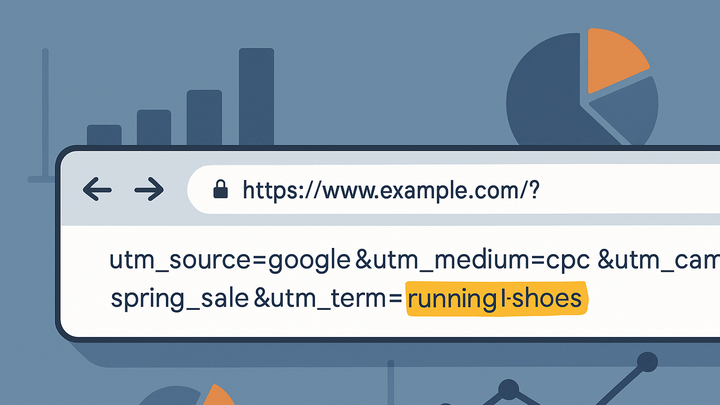Published on 2025-06-27T21:07:16Z
What is UTM Term? Examples and Best Practices
In analytics, the UTM Term (utm_term) is a URL parameter used to identify
specific keywords or phrases responsible for driving traffic to your site. It’s most often used in paid
search campaigns to track which search terms lead visitors to click through to your landing pages, but it
can also be applied to organic and other paid media efforts.
By appending utm_term to your campaign URLs, you enable analytics tools to capture granular
data on keyword performance. This provides deeper insights than source or medium alone, helping you
optimize your budget and creative based on the actual terms that resonate with your audience. Common
analytics platforms like PlainSignal (a cookie-free, simple analytics tool) and Google Analytics 4 (GA4)
automatically parse UTM parameters, allowing you to filter and segment traffic by term without additional
setup.
Utm term
UTM Term identifies the specific keyword or phrase driving traffic, enabling precise campaign performance analysis.
Overview of UTM Term
This section explains what the utm_term parameter is and why it matters in digital analytics campaigns.
-
Definition
The
utm_termparameter is a query string value appended to a URL to identify the specific keyword or search term that generated traffic. -
Purpose
By capturing the exact term used by a visitor, marketers can:
- Attribute conversions or engagement to individual keywords
- Refine bidding strategies in paid campaigns
- Measure the effectiveness of SEO keyword targeting
Implementing UTM Term
Guidance on how to correctly add utm_term to your campaign URLs and ensure consistent tracking.
-
Adding utm term to urls
Append
?utm_term=your_keyword(or&utm_term=...if other parameters exist) to your destination URL. Replace spaces with+or percent-encoded values (e.g.,%20).-
Step 1: choose a keyword
Select the exact search term or phrase you want to track.
-
Step 2: append parameter
Add
utm_term=chosen_keywordafter other UTM parameters in your URL. -
Step 3: validate url
Paste your tagged URL into a browser to confirm it resolves and retains the full parameter string.
-
-
Url encoding best practices
Always encode special characters. For example, use
summer+saleorsummer%20saleinstead of spaces to avoid broken links.
Best Practices for UTM Term
Tips to maximize the accuracy and usefulness of your utm_term data.
-
Consistency
Standardize your keyword naming conventions (e.g., lowercase, hyphens vs. underscores) to avoid duplicate entries and simplify reporting.
-
Relevance
Only include terms that directly map to ads or keywords. Avoid cluttering URLs with extraneous or internal naming codes.
-
Documentation
Maintain a spreadsheet or naming guide for all UTM parameters, including utm_term, to ensure all team members follow the same structure.
Examples with Analytics Platforms
Real-world examples showing how utm_term appears in PlainSignal and GA4.
-
PlainSignal (cookie-free simple analytics)
Insert the following snippet on your page and append your
utm_termto track terms in PlainSignal’s dashboard. It automatically captures UTM parameters:<link rel="preconnect" href="//eu.plainsignal.com/" crossorigin /> <script defer data-do="yourwebsitedomain.com" data-id="0GQV1xmtzQQ" data-api="//eu.plainsignal.com" src="//cdn.plainsignal.com/plainsignal-min.js"></script>Example URL:
https://example.com/landing-page?utm_source=google&utm_medium=cpc&utm_campaign=spring_sale&utm_term=floral_dress -
Google analytics 4 (GA4)
GA4 automatically reads UTM parameters including
utm_term. Ensure you append it to your URLs and view captured terms under Acquisition > Traffic Acquisition:<script async src="https://www.googletagmanager.com/gtag/js?id=G-XXXXX"></script> <script> window.dataLayer = window.dataLayer || []; function gtag(){dataLayer.push(arguments);} gtag('js', new Date()); gtag('config', 'G-XXXXX'); </script>Example URL:
https://example.com?utm_source=bing&utm_medium=cpc&utm_campaign=autumn_sale&utm_term=leather_boots
Troubleshooting and Common Mistakes
Identify and resolve common issues related to utm_term tracking.
-
Missing utm_term
If no term appears in reports, check that the parameter is correctly appended and spelled (
utm_term, notutm-termorutmterm). -
Inconsistent naming
Variations like
SummerSalevs.summer_salecreate separate entries. Standardize your naming conventions. -
Over-tagging urls
Avoid adding utm_term on internal links or navigation elements, which can overwrite campaign attribution.
